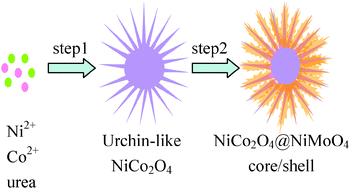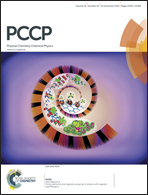Seaurchin-like hierarchical NiCo2O4@NiMoO4 core–shell nanomaterials for high performance supercapacitors
Abstract
A novel electrode material of the three-dimensional (3D) multicomponent oxide NiCo2O4@NiMoO4 core–shell was synthesized via a facile two-step hydrothermal method using a post-annealing procedure. The uniform NiMoO4 nanosheets were grown on the seaurchin-like NiCo2O4 backbone to form a NiCo2O4@NiMoO4 core–shell material constructed by interconnected ultrathin nanosheets, so as to produce hierarchical mesopores with a large specific surface area of 100.3 m2 g−1. The porous feature and core–shell structure can facilitate the penetration of electrolytic ions and increases the number of electroactive sites. Hence, the NiCo2O4@NiMoO4 material exhibited a high specific capacitance of 2474 F g−1 and 2080 F g−1 at current densities of 1 A g−1 and 20 A g−1 respectively, suggesting that it has not only a very large specific capacitance, but also a good rate performance. In addition, the capacitance loss was only 5.0% after 1000 cycles of charge and discharge tests at the current density of 10 A g−1, indicating high stability. The excellent electrochemical performance is mainly attributed to its 3D core–shell and hierarchical mesoporous structures which can provide unobstructed pathways for the fast diffusion and transportation of ions and electrons, a large number of active sites and good strain accommodation.


 Please wait while we load your content...
Please wait while we load your content...